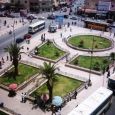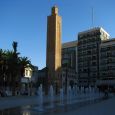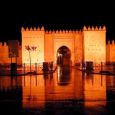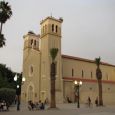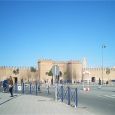Oujda
Advertisement
By Air
Angads Airport (IATA: OUD, ICAO: GMFO) is an airport serving Oujda,a city in the Oriental region in Morocco. Also known as Oujda Angads Airport, it is located about 12 kilometres (7 mi) north of Oujda and about 600 kilometres (373 mi) northeast of Casablanca, near the Algerian border.
By Train
The city is the endpoint of the main railroad from Casablanca via Fes and Taourirt before the border with Algeria.There are several day and nighttrains to and from the city linking it to the Western part of the country.Three trains a day arrive from Western Morocco.From Fez, the trip will take about five and a half hours and cost exactly 158/108 Dirhams (First/Second class).
By Car
Oujda is accessible from the North via Melilla / Nador as well as from the West via Fes / Taza. Arriving from the South is also possible from Figuig and Bouarfa.Currently, the Algerian border is closed which prevents land travel to/from the East.There are grand taxi's to many destinations including: Taza, Saidia (20 dirhams), Berkane (18 dirhams), Jerada (15 dirhams), Ain Beni Mathar (15 dirhams).
By Bus
The bus station is located next to the grand taxi station in the South of the city.Many destinations are possible.From Oudja to Taza is roughly 30 dirhams, Oujda to Fes around 60 dirhams.
Atlas Mountains
The High Atlas features some of the most beautiful regions of Morocco, Algeria and Tunisia.These mountains are the highest in the area, with Toubkal stretching to 4.165 meters above sea level.The Middle Atlas reaches heights of 3,350 meters and the highest peaks of the Anti Atlas reach 2.531 meters.The High Atlas has walks to suit all abilities, but mules and horses are also available in the villages if riding suits you better than walking.The villages in the High Atlas are small but thriving and are home to the Berbers who are enduring, hospitable and very friendly people.The villages offer stylish Moroccan accommodation in the local houses and there are established guides available. The high peaks force the clouds to give high quantities of rainfall; therefore the High Atlas has many fertile valleys surrounded by rivers and waterfalls.Mineral deposits found in the Atlas range include gold, silver, lead, iron, phosphates, lead and zinc.
Zagora Camel Trekking
Unless you already have an affinity for these animals, you probably shouldn't try a camel trek that lasts longer than a day. While the experience can feel authentic and provide an interesting way to see the sights, it can also make you feel sore and tired.Despite these after-effects, it is still well worth the effort.
Essaouira Windsurfing
Welcome to the Moroccan town of Essaouira! No longer a mid-1960's hippy hangout (Jimi Hendrix used to party here); Essaouira has evolved into a still-undiscovered gem of pristine beaches, great windsurfing, laid back nightspots and hearty restaurants.The narrow streets keep traffic to a minimum and encourage walking. With little effort you'll find yourself walking past the multi-colored doors, tall stucco-colored houses and the eclectic mix of euro-tourism and weather-worn locals.
Mount Toubkal
Standing at an intimidating height of 4 167 meters, Toubkal is the highest peak in the Atlas Mountain range. It is located just outside of Marrakech, in the breathtaking Toubkal National Park.No-one is exactly sure when the first ascent of this peak took place, as the first date documented is 12 June 1923. Hubert Dolbeau, the Marquis de Segonzac and Vincent Berger were the first Europeans to climb Toubkal, but it is possible that the mountain had been ascended before them by Berber tribesmen while on hunting expeditions, but was never documented.Today it is a popular mountain climbing destination, and mountaineers from all over the world come to Morocco to take on this magnificent peak.
Taourirt Kasbah
The palace building has almost three hundred rooms, and more than twenty riads formed part of the settlement which was occupied by the sons, cousins and extended family of el Glaoui chiefs, along with their servants.They were located there to protect the interests of the clan chiefs in this strategically important area.This control was supported by the French authorities during colonial rule, as the el Glaoui leaders kept the southern tribes in check.Local families living toward the rear of Taourirt Kasbah are keen to show visitors around and offer gems of historical information – for a fee. To the right of the Kasbah is a cafe which offers visitors refreshment and a place to relax and watch Taourirt Kasbah being drenched in shades of gold and copper by the setting sun.
Information not available


